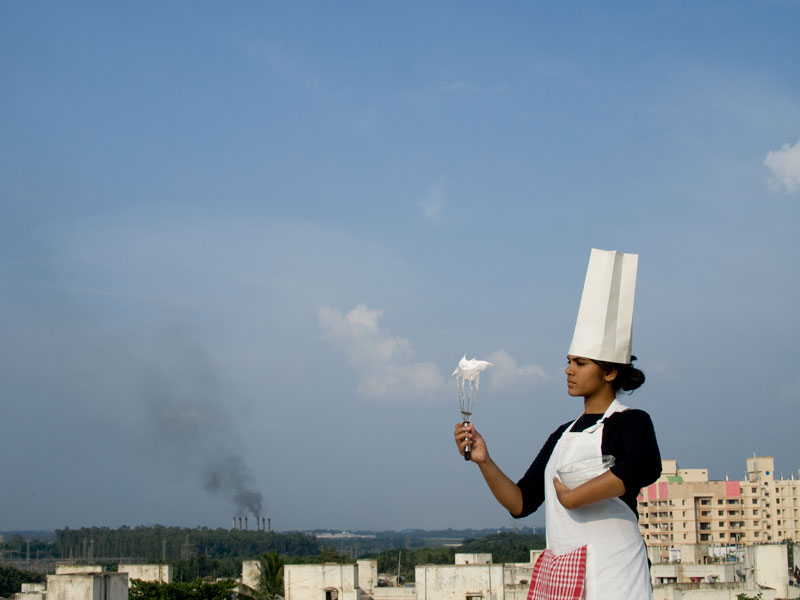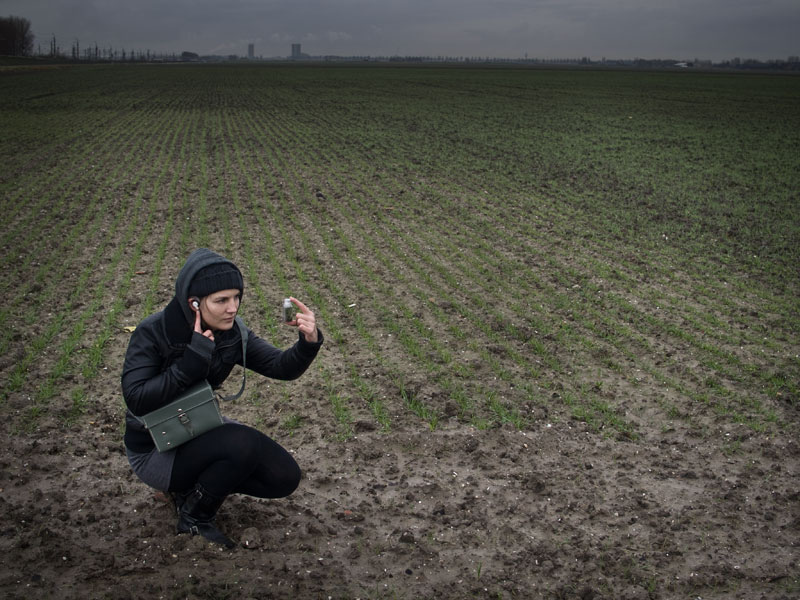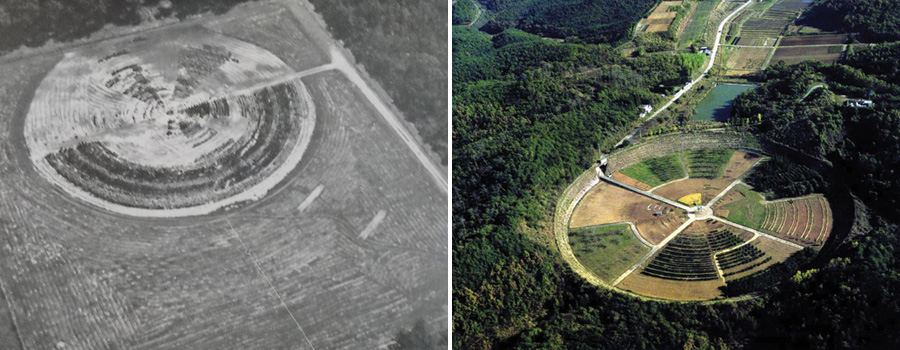SEAWEED WALL by The Center for Genomic Gastronomy, an exhibit at the EDIBLE exhibition at SCIENCE GALLERY, Trinity College Dublin, Ireland in 2012
BLOG
Feeding Times at Edible
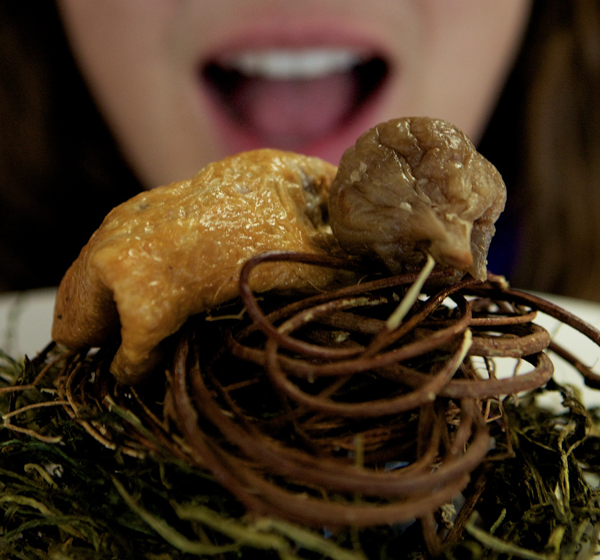 Feeding Times Special: Vegan Ortolan
Feeding Times Special: Vegan Ortolan
The Center for Genomic Gastronomy curated the current exhibition at the Science Gallery, EDIBLE. We were really excited about getting visitors to experience parts of the exhibition through taste – one of the senses that is often disregarded in exhibitions.
To bring this component to life we commissioned culinary extraordinaire Heather K. Julius (who also runs the Special Snowflake Studio) to develop recipes, challenging her to create dishes such as the Vegan Ortolan. It was an inspiring collaboration and you can find all of Heather’s recipes for edible, as well as recipes from other foodies, chefs and scientists on the Science Gallery website.
The feeding times will run twice daily for the duration of the exhibition, serving a new recipe every three days. Today was the first day for Vegan Ortolan.
ABOUT VEGAN ORTOLAN
The traditional preparation of the ortolan bird in France demands that they are captured alive, force-fed, drowned in Armagnac and eaten whole. Although it is illegal to prepare and eat, the dish retains a forbidden attraction for some adventurous eaters. What better way to challenge the skills of a chef than to create a vegan recipe which simulates the experience of crunching through the skin, guts and bones of a small bird, without using any animal products? This dish is intended to be consumed in the traditional way with a large napkin covering the head and the face to keep the flavours in, and to hide one’s shame from God.
Tasting notes for traditionally prepared ortolan emphasize the rich foie gras like taste of the flesh, the crunch of the many tiny bones and the bitterness of the guts.

The feeding time specials change every three days for the duration of the exhibition. Here is Conor updating the times for today.

The nests are ready and the Eaters are taking their seats.
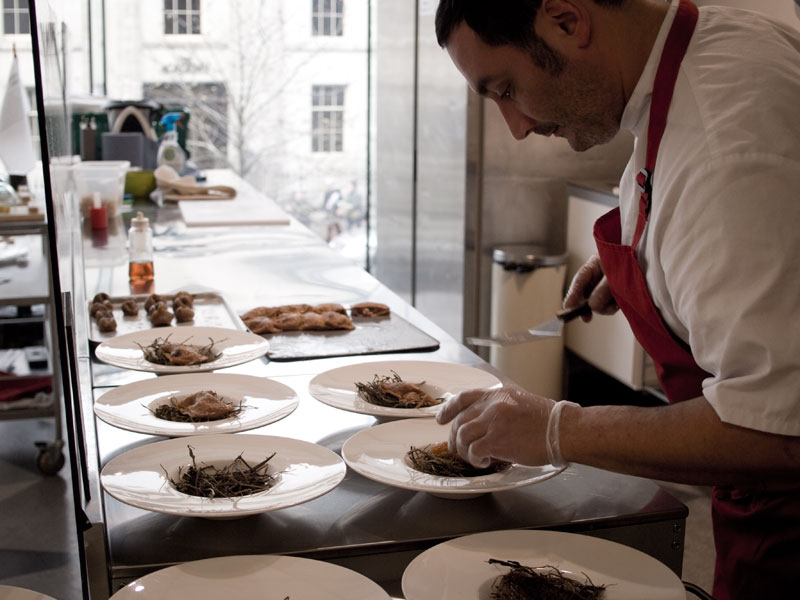
Enguerran, head chef for the exhibition is plating the vegan ortolan.
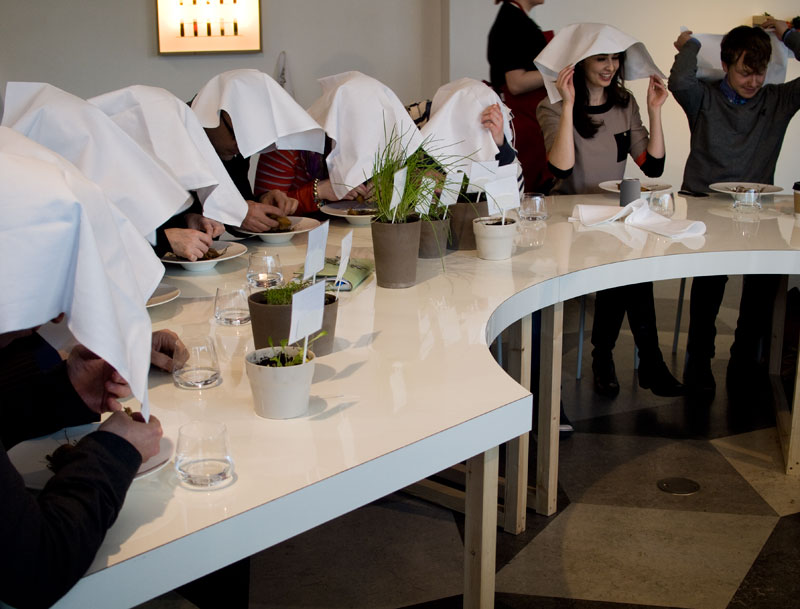
The dish is traditionally eaten with a cloth over your head – to keep the aromas in and to hide your shame from God.
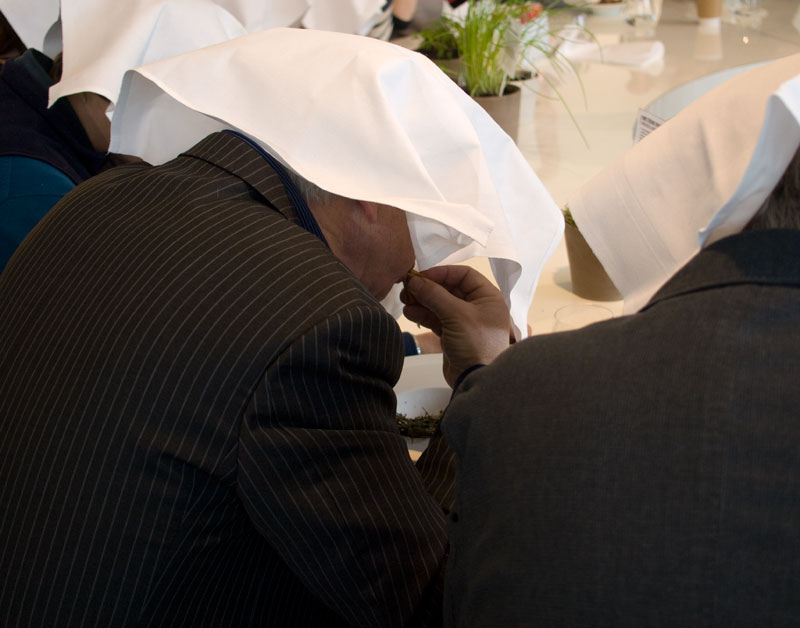

The Fig symbolises the head and beak, while the body is represented by a tofu pocket.
Q&A with the Edible Curator
Q&A with the Edible Curators: Cat Kramer & Zack Denfeld
Why make an exhibition about food?
Every Eater has a stake in the future of food so it’s encouraging that people are increasingly interested in what kinds of food they eat. This awareness of food issues is driven by various motivating factors; from personal health to concerns about global resource depletion. Creating an exhibition about food can be quite challenging because of the number of voices and perspectives that deserve to be included. There are many strong, and often conflicting, opinions about this universal requirement for survival. However, we find this widespread engagement inspiring and hope the exhibition captures some of this energy.
How does EDIBLE respond to such a broad topic?
There have been a number of exceptional exhibitions on agriculture, urban farming and imagining the ways we are going to feed the 7 billion+ humans on planet Earth in the last few years. However, early on in the process of developing EDIBLE, we decided to narrow the scope and focus on the experience of eating under the maxim: ‘Eaters are agents of selection’. We wanted to make a more explicit connection between the kitchen and the biosphere, and the way individual chefs and Eaters serve as a bridge between these two domains. It was really important to us that visitors to the exhibition get to eat foods (and readers of this catalogue get to use the recipes printed). We are excited to see how the possibility of eating the exhibits, rather than just looking or touching, invites discussion and debate.
What do you mean by ‘Eaters are agents of selection’?
Most Eaters accept that animal and plant breeders have steered evolution for thousands of years. However, Eaters and chefs also exert selection pressures on the kinds of life forms & ingredients that are propagated within the eco-agro-culinary system. Every human Eater slowly reformulates the planet as they consume it.
The daily choice we make about what to eat for dinner, whether it’s a Big Mac meal or a homegrown salad, impacts the diversity, abundance and distribution of life on the planet. As such, you are an agent of selection.
We have assembled a collection of artefacts, recipes and stories that we think typify some of the ways humans unconsciously sculpt the planet’s biosphere through eating habits, flavour preferences and food technologies. We hope this exhibition is an opportunity to explore the co-evolution of gastronomy and larger ecological, technological and political systems.
You mention ingredient selection as one vector for change within the food system. Can you tell us about some of the interesting ingredients featured in EDIBLE?
Within this catalog and in the show EDIBLE you will find that many of the artists, scientists and chefs have a very particular relationship to the life forms they prepare and serve. Some are interested in the nutritional or ecological implications of the ingredients they serve, while others have chosen foods that have an important or hidden history.
In terms of genetic diversity, Oliver Moore recommends 3 different varieties of beetroot (Boltardy, Cylindra & Chioggia) for his community-farm-inspired juice recipe (page xxx). We have also selected 12 varieties of potatoes cultivated and maintained by Irish Seed Savers as a way of acknowledging all of the largely uncelebrated work on selective breeding that farmers and breeders have done for centuries.
We also feature a number of edible plants that remain under-explored, despite the insatiable appetite of humans. Dr. Prannie Rhatigan has been making the case for incorporating more seaweed in the Irish diet through writing, speaking and serving delicious recipes (see page xxx for an example). In this show we feature eight varieties of edible seaweeds that may be new to most eaters, and will also be serving one of her dishes.
This exhibition also includes examples of culinary trends, such as invasivorism (eating invasive species – page xxx) and entomophagy (eating insects – page xxx). Do these practices raise concerns? Are they simply fads, or compelling enough to propagate into kitchens and restaurants more broadly? Our own work includes a radiation-bred variety of mint (page xxx) and glowing sushi, which calls for a transgenic fish usually sold as a pet (page xxx). The line of what we consider a food and edible is constantly fluctuating.
What do you believe is the taste of things to come?
The future of food is much more complex than we can predict. But we are sure that it will look nothing like the techno-utopic image of life-extending pill food eaten in outerspace or the return to a neo-feudal agricultural economy imagined by doomers within the peak oil and climate change communities. However, we do expect that there will be a major change in the kinds of ingredients we use, and hope that food systems will increasingly privilege resilience over efficiency.
If one takes a long view of history, it is incredible that ingredients like potato, tomato, chili peppers, corn and chocolate have only recently gone global. Before the 16th century none of these five ingredients were known outside of the Americas, and now they play a central role in human diets in many places on the planet. Today, ingredients like Quinoa and pomegranate are increasingly cultivated as Eaters demand them, and we think that there are a number of edible plants out there that will become dominant over the next 100 years because of their medicinal, nutritional or gastronomic properties. This new set of dominate genomes will probably come out of left field. New food technologies and recipes will build on and reinforce this new genomic regime, and in a perfect world, the ingredients Eaters prefer will run in parallel with an increasingly sustainable food system.
We are excited about hearing what visitors to the exhibition believe will be the taste of things to come, and hopefully some of the foods they taste will serve as inspiration.
Putting people back into food futurism
As we begin our research for our DA4GA project, Edible Time Machine, we are putting the finishing touches on the EDIBLE exhibition at the Science Gallery in Dublin, Ireland. Three of the projects we are exhibiting in the show should give some indication of the direction we will be heading in over the next few months:
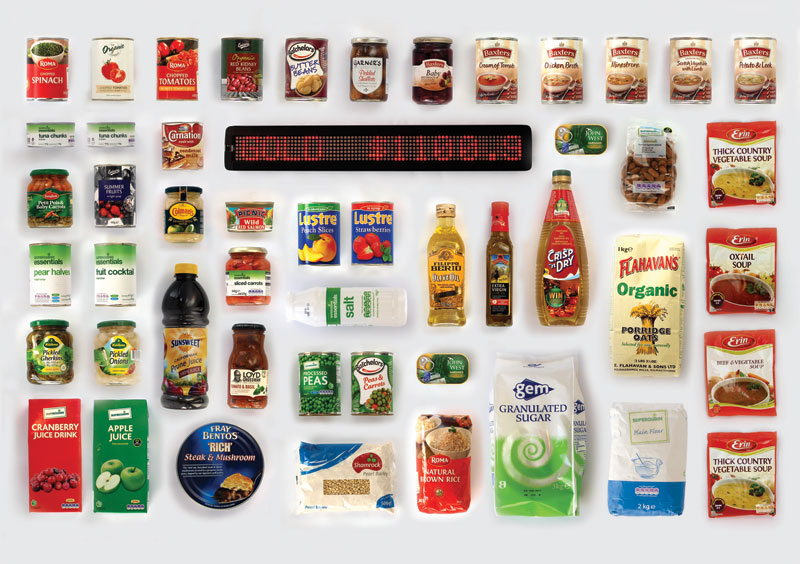 DOOMER FOOD: BEANS, BULLETS & BULLION
DOOMER FOOD: BEANS, BULLETS & BULLION
The Edible Time Machine project will seek out interesting ingredients and develop 5 recipes, providing five different ways to think through the future of food systems. Our research process runs concurrent with NCHA‘s Growing Older Together study, and will draw on the food preferences, memories and narratives of research participants as one source of inspiration.
One of the things we hope to contribute through this process to our collaborators and colleauges in the Life Sciences and Healthy Ageing research is a much more diverse, critical and nuanced way of imaging the future of food, and healthy ageing. Especially when employing the lens of Biotechnology and Genomics.
Most of the timelines and narratives we have run into that imagine the future of food and health through the lens of emerging technologies seem to return to the same top-down and techo-deterministic themes of:
* nutraceuticals
* genetic modification (transgenesis & cisgenesis)
* in-vitro meat
* vertical farms
* gene therapy
* personalized medicine
* entomophagy (eating insects) because it is “efficient”…etc.
Here are just two timelines of the future of technology (including food) that we have run into in the last this week:
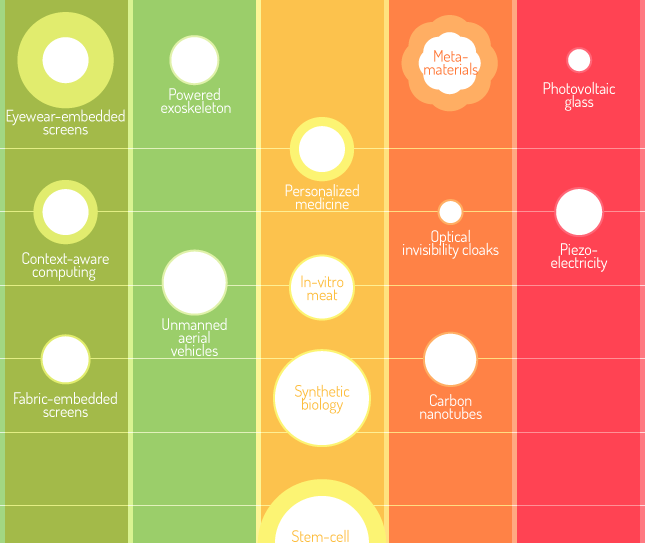
Envisioning Emergent Technology popped up in our blog feed today and includes these predictions for the near future:
* In-vitro meat
* vertical farming
* Smart Drugs
* Personalized Medicine
* Anti Ageing Drugs
Here is the timeline of Biotechnology from Naturalis:
It includes the following predictions for the future:
* “The last farm is closing down. Our food is increasingly being produced from algae grown in huge tanks.” (((That didn’t work out so well in Windup Girl. However, we ARE intrigued by the idea of a currency based on calories, instead of gold or fiat.)))
* “We have solved all of the mysteries of DNA, but have still not managed to eradicate diseases and death.”
* “Cloning humans is by now medically safe, and the ethical objections are diminishing.”
* “Barren areas, such as deserts, are now used for agriculture. Genetically engineered crops have made these areas fertile.”
* “People live even longer; hence the age of retirement rises to eighty years.” (((Is Greece getting a jump start on this one?)))
There are many well written critiques of technologically-deterministic-futurism including the recently penned The Future Isn’t What it Used To Be from a futurist insider, and the more academic Meals to Come (“accuracy is only one of many reasons why people make predictions.”), so we won’t rehash those arguments in this short space.
The Naturalis Biotechnology timeline exhibit is only one floor down from where our piece will be installed. We are hoping that our artwork serves as a counterpoint by explicitly including ethical, social, cultural and flavor aspects that don’t seem to be factored into much forecasting that uses Science & Technology as its lens.
Here is just a rough list of possible topics that we hope to pursue in the coming months:
* Culinary Eugenics / Biodiversity of the Kitchen / Resistance to Fungible Ingredients
* 2012 Paranoia / End of Empire / Doomer Food / Stockpiling / Hoarding
* Junk Science/ Fad diets / Fast Food Forecasting driving consumer & eater behavior
* Individuals doing things with food technology that were not intended
* The Culinary Innovations of Peak Oil / Economic Contraction / Energy Shortages / Climate Change
Food Lab Bangalore
Over the next 3 weeks the Center for Genomic Gastronomy is holding a workshop with sophomores from the Srishti School of Art, Design & Technology in Bangalore, India. The students have signed up for their workshop because they are interested in food and food culture. Working with two researchers from the Center the students will examine innovation and conservation in South Asian food cultures, building on recent research of the Center (utopian cuisines, mutagenic meals) and working towards the next edition of the Planetary Sculpture Supper Club to be held in Bangalore on Nov. 12th.
Follow the conversation all week here on our Blog, join in the comments and use the twitter hashtag #foodlabbangalore to keep up to date.
Gamma Gardens & Caesium 137
INTRODUCTION
The radiation breeding of seeds using radio isotopes has been practiced for less than 100 years. Although this research began in the 1920’s, there was a concerted effort to find ‘peaceful’ uses for atomic energy, after World War 2. Some nuclear scientists hoped that radiation breeding would contribute towards global food security and decreased hunger.
Atoms For Peace symbol used by the United States Atomic Energy Commission on a document cover page in 1955. It was mounted over the door to the American swimming pool reactor building during the 1955 International Conference on the Peaceful Uses of Atomic Energy in Geneva. Around a representation of an atom are symbolised four areas civil atomic energy: scientific research, medicine, industry, agriculture. Two olive branches symbolise peaceful use. (wikipedia)
The Atoms for Peace symbol from 1955 includes a bushel of wheat on the left, symbolizing the potential non-military application of the atomic program in agriculture. However, the cultivars created through radiation breeding programs have not met the hype of early advocates. Cultivars such as the KinnowLS Mandarin Orange are still being created and released today, but radiation breeding has not had the radical effect on agricultural systems that was predicted, especially when compared to the green revolution or the emergence and battle over genetically engineered crops.
GAMMA GARDENS IN ACTION
Paige Johnson, nanotechnologist and blogger at Garden History Girl has been researching early radiation breeding research, especially Gamma Gardens.
Gamma gardens are test facilities where plants are exposed to radiation, in order to generate a range of unpredictable mutations, more quickly than would happen due to non-radiated environmental exposure.
Left: A gamma garden at Brookhaven National Labs, New York, c. 1958; image provided by Paige Johnson. Right: For a clearer view, a modern-day gamma garden at the Institute of Radiation Breeding, Hitachiohmiya, Japan; photo courtesy of the institute.(via)
These gardens are set up as circular fields where crops closest to the center are completely mutated while smaller doses and less mutation happens at the edge of the circle. These gardens were bordered by protective shielding dikes which were erected to contain the radiation and limited the exposure to living things outside of the dikes. In Japan these fields had to be at least one kilometre away from the nearest residential areas. A gamma source of either Cobalt- 60 or Caesium-137 was placed at the centre of the field and the plants were exposed different doses of gamma rays for 7 – 8 months. In A. M. van Harten’s Mutation breeding: theory and practical applications Caesium-137 is recommended for agricultural use because it has the “relatively” short half-life of 33 years.
However, this procedure can be carried out in growing chambers or even greenhouses. For long terms growth trials exposure is carried on for months and can be given in specifically prescribed doses.
The most obvious question is- would ingesting plants of these seeds harm us in any way? Could the mutations cause known allergens to be present or have other genotypical changes that would be agronomically interesting, but otherwise harmful to an human eater’s health? Our environment already emits some amounts of radiation, in what ways is directed mutagenesis useful or dangerous in the long run? What is the aggregate effect on agricultural biodiversity?
Contemporary writers and journalists are increasingly interested in this topic, but the history of the science and these experiments is still being reassembled and evaluated especially in relation to other human health, food system and environmental concerns.
CAESIUM 137: THE DOUBLE AGENT
Earlier this year the earthquake in Japan resulted in a fall out in the nuclear plant at Fukushima releasing dangerous amounts of Caesium-137 amongst other isotopes. The agricultural lands in the vicinity absorbed this substance and were so contaminated that in many areas people were forbidden to plant rice.
Ironically it’s the very same isotope used for irradiation and mutagenic breeding.
Graph of radiation release from the Fukushima I Nuclear Power Plant following the 2011 TÅhoku earthquake and tsunami, compared to historic events and standards. Updated to show time series geographical effects, local site map, and news reporting. See http://www.rchoetzlein.com/theory/?p=171 for additional discussion and commentary on this image.
Resources:
1) Mutation breeding: theory and practical applications By A. M. van Harten
2) Symposium on Mutation and Plant Breeding By National Academy of Sciences. Agricultural Board
3) http://pruned.blogspot.com/2011/04/atomic-gardens.html
FoodLab Bangalore – is a 3 week workshop the Center for Genomic Gastronomy conducted with sophomores from the Srishti School of Art, Design & Technology in the fall of 2011. Students will examine innovation and conservation in South Asian food cultures, building on recent research of the Center (utopian cuisines, mutagenic meals) and working towards the next edition of the Planetary Sculpture Supper Club to be held in Bangalore on Nov. 12th.
Follow the conversation all week here on our Blog, join in the comments and use the twitter hashtag #foodlabbangalore to keep up to date.
The X-Plants: Radiation Breeding in Indian Agriculture
India has released about 1 in 10 of the mutagenically-bred varietals on the planet, with a focus on mutant breeds of rice, wheat and black dal. These genomes are selected for chemical and radiation breeding experiments because they are ubiquitous in the Indian diet. During breeding trials mutagenic cultivars are selected based on traits such as disease resistance and size and their agronomic suitability for the growing conditions in the northern states of Bihar, Gujarat, Maharashtra, Rajasthan and Punjab.
 As far as we can tell mutagenic varietals in India are not being cultivated or selected based on changes in flavor, color or texture. Flavor or culinary considerations are not explicitly mentioned as selection mechanisms in this research.
As far as we can tell mutagenic varietals in India are not being cultivated or selected based on changes in flavor, color or texture. Flavor or culinary considerations are not explicitly mentioned as selection mechanisms in this research.
Mutation breeding was introduced to india in 1957 by the IARI (indian Agriculture Research Institute) which is the premier national instate for agriculture research, education and extension. This mutagenic research predates the green revolution in India.
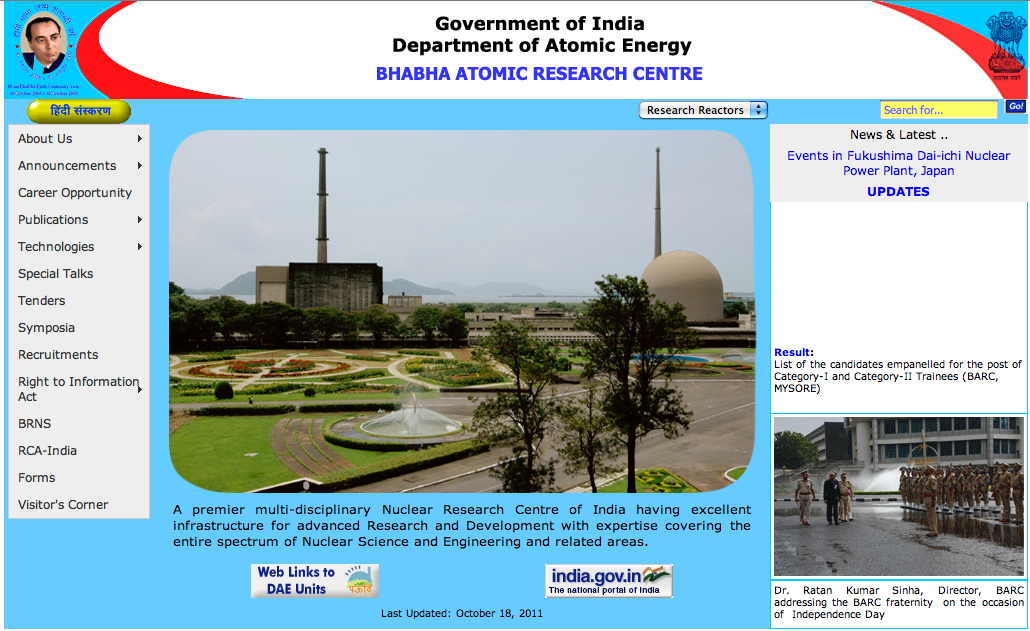 Many countries use their civilian nuclear programs and research facilities to carry out mutagenic and transgenic agriculture research. At India’s Bhaba Atomic Research Centre in Trombay, Maharashta they have a long list of the cultivars that have been generated. According to the amazingly chaotic and colorful website:
Many countries use their civilian nuclear programs and research facilities to carry out mutagenic and transgenic agriculture research. At India’s Bhaba Atomic Research Centre in Trombay, Maharashta they have a long list of the cultivars that have been generated. According to the amazingly chaotic and colorful website:
“The Trombay crop varieties have been popularized through various awareness programmes, exhibitions, kisan melas and farmer’s rallies.”
FoodLab Bangalore – is a 3 week workshop the Center for Genomic Gastronomy conducted with sophomores from the Srishti School of Art, Design & Technology in the fall of 2011. Students will examine innovation and conservation in South Asian food cultures, building on recent research of the Center (utopian cuisines, mutagenic meals) and working towards the next edition of the Planetary Sculpture Supper Club to be held in Bangalore on Nov. 12th.
Follow the conversation all week here on our Blog, join in the comments and use the twitter hashtag #foodlabbangalore to keep up to date.
Rasam Deconstructed
If cheese varieties are set in stone, with PDOs protecting their process Rasam is an open source culinary ecology. A little of this and a little of that, what is in season, what is available etc.
FoodLab Bangalore – is a 3 week workshop the Center for Genomic Gastronomy conducted with sophomores from the Srishti School of Art, Design & Technology in the fall of 2011. Students will examine innovation and conservation in South Asian food cultures, building on recent research of the Center (utopian cuisines, mutagenic meals) and working towards the next edition of the Planetary Sculpture Supper Club to be held in Bangalore on Nov. 12th.
Follow the conversation all week here on our Blog, join in the comments and use the twitter hashtag #foodlabbangalore to keep up to date.
CURRENT & UPCOMING
April 9th - 10th 2024
Future Foodscapes. Ground Truth.University of Barcelona / S+T+ARTS MU SAE. Barcelona, ES.January 28th - May 29th 2023
Live and Let Live. To Flavour Our Tears. Museum Jan Cunen. Oss, NL.February 15h - April 30th 2023
More Meat Less Meat. New National Dish: Norway. Trondheim Kunstmuseum Gråmølna. Trondheim, NO.February 15h - April 30th 2023
More Meat Less Meat.Meatball Multiverse. Trondheim Kunstmuseum Gråmølna. Trondheim, NO.October, 2021 - June, 2022
Drought in Waterland, S+T+ARTS4Water, Veluwe region, NLSeptember 23rd - October 02nd 2022
WaterWORKS. Food Forest Fantasies. V2_ Lab for the Unstable Media, Rotterdam, NLNovember 19, 2021 - October 01, 2022
Planetary Indigestion, University of California Santa Cruz, USApril 27th - October 07th 2022
Balcony for the brave. De-Extinction Dinner. Hyundai Blue Prize Art+Tech 2022, Beijing, CN.April 21st - August 29th 2022
Does the Blue Sky Lie? Guided Smog Meditation. New Delhi, IN. KHOJ.October 08th - 10th 2021
Przemiany Exhibition. New National Dish: Poland, Copernicus Science Centre. Warsaw, PLNovember 18, 2021 - December 12, 2021
Grafill, risography exhibition, Oslo, NOOctober 16, 2021
SmakÅs, food and technology festival, Ås, NOSeptember 16, 2021 - December 31, 2021
Food Phreaks! Biodiversity of the Kitchen, Center for Genomic Gastronomy Solo Show, Norwegian Center for BioArt (NOBA), Vitenparken at Ås, NorwayOctober 13-15, 2021
ARTECH Contingency Exhibition, Aveiro, PTJune 12, 2021 - August 29, 2021
'Breathe Deep', exhibition at Tomorrow Maybe gallery, HKApril 24, 2021
OFF-biennale, Smog Tasting, Budapest, HUJanuary 11, 2021 - January 11, 2023
‘Cultures of Biotech’ Art’s Work in the Age of Biotech, online Exhibition at University of Pittsburgh, USDecember 11, 2020 - May 06 2021
'Welcome to the O.F.F.I.C.E', BAD Award expo Evolutionaries, MU Eindhoven, NetherlandsSeptember 02, 2019 - May 08, 2020
SEED-O-MATIC, Colby College Museum of Art. Maine, US.March 06 -07, 2020
Digital Wild (Conference), Trondheim Electronic Arts Centre. Trondheim, NO.January 24 - 25, 2020
QuozArt Festival 2020, Alserkal. Dubai, UAE.January 20, 2020
Bergen Center for Electronic Arts. Food Phreaks: Taste, technology, and open culture. Bergen, NO.November 08 - 10 2019
Microwave International New Media Arts Festival 2019: E.A.T. Smog Tasting Take out, To Flavour Our Tears. Hong Kong, CN.October 24 - November 21, 2019
ClimATE, Aalto University, Espoo, FI.October 11, 2019
Edible Futures - Friday Forum. V&A Museum. London, UK.August 23 - September 11, 2019
Da Vinci Creative Festival 2019: Living life. KoreaJune 07 - 10, 2019
The Agri-Cultures.Seed-Links Exhibition. Svalbard, NO.17 May - 29 September,2019
Creatures made to Measure. Design Museum. Ghent, BE.May 30 - June 05, 2019
Women in Art, Science and technology, FEMeeting, 2019. Lisbon, Porto, PT.February 28, 2019 - March 2, 2019
Sustainable Foods, Kavli Frontiers of Science Symposium, 2019. Irvine, California, US.February 14 - March 02, 2019
Interactivos 2019: Eating Against Collapse, Medialab-Prado, Madrid, ES.November 30, 2018 – March 10, 2019
TFOT: AnthroAquaponics System, Reshape, MU Artspace, Eindhoven, NLDecember 02, 2018 – April 28, 2019
Food Revolution 5.0, GEWERBE MUSEUM - A collaboration with Museum of Arts and Crafts (MKG).Hamburg, DE.October 03 -06, 2019
New National Dish, Przemiany Festival, Copernicus Science Centre. Warsaw, Poland.September 16, 2018-January 6, 2019
De-Extinction Deli, Creatures Made to Measure – Animals and Contemporary Design, Museum Marta Herford, GermanyAugust 24, 2018
To Flavour Our Tears Talk, RISD, Biodesign SymposiumAugust 24-September 27, 2018
To Flavour Our Tears, RISD Nature Lab, Biodesign ExhibitionApril 11 - Oct 08, 2018
New National Dish, MAAT Museum’s exhibition ECO-VISIONARIESJune 22, 2018
Endophyte Supper Club, Dublin, IrelandJune 19, 2018
Talk, Endophyte Club, The Irish Architecture FoundationMay 12 - NOV 04, 2018
Food Future Canapés, The Future Starts Here, Victoria and Albert Museum, London,UK.May 25 - 27 2018
Talk, Design Matters, Reconnecting Taste & Place, Hangzhou, ChinaApril 13, 2018
De-Extinction Dinner, Science Gallery DublinMarch 1, 2018
Climate Fiction PTDec 21, 2017
Serendipity festival, Goa IndiaOctober 21 - 29, 2017
Dutch Design Week: Embassy of FoodOctober 19 - 21, 2017
Experiencing Food (Lisbon)October 2nd, 2017
Variety Showcase, Culinary Breeding NetworkAug. 9-10, 2017
Hackers & Designers Summer AcademyJune 23-24, 2017
Zine Hotspot — Cork Printmakers @ WaterstonesMay 2017
NEPTUN ART/ SCIENCE LABNov. 8, 2016
New National Dish, Jeu de PaumeNov. 5 - Apr. 2, 2016
2116: Forecast of the Next CenturyNov. 5th, 2016
KiKK Festival WorkshopOCT. 14-16, 2016
Pixelache Festival visiting JYVÄSKYLÄOct. 12, 2016
Couterfactual Cuisine at IFTFSept 22-25, 2017
Pixelache Festival, Interfaces for EmpathySept 15, 2016
Food in Space, ESA, London Science MuseumJune - September 2016
Medialab Prado: Interactivos 10-Year CelebrationSpring 2015 - Summer 2016
Leverhulme Trust, Artist in Residence, the Rowett Institute, ScotlandMay 27-29, 2016
May Festival, Aberdeen. Food ForecastMarch - July 2016
2116 @ Glucksman Gallery, Cork, Ireland10 March - 05 June 2016
FIELD TEST Exhibition, Science Gallery, Dublin18 March 2016
Soylent Banquet, Internet Stadl, Dusseldorf9—21, FEB 2016
SMOG TASTING: SMOG SYNTHESIZER5-6 Febrary
De-Extinction Deli, AND Fair, Rijeka Croatia29 January 2016
De-Extinction Deli, V&A LondonRECENT POSTS
- Food Forest Taste Test
- Databases of Taste (A Solo Exhibition?)
- WHY AREN’T YOU BIO-MAXXING?
- FFTT: April 1 Flevoland Site Visit
- DATABASES OF PLACE & TASTE: Significant species, cultivated plants & observed organisms.
- Terroir That Travels in Lautrec, France
- Terroir That Travels: Making Maps
- GGGarden Update — Autumn 2024 Edition
- Food Forest Taste Test: First Test Kitchen
- FOOD FOREST TASTE TEST: Voedselbos Thuishaven
Archives by Month:
- October 2025
- September 2025
- June 2025
- March 2025
- January 2025
- October 2024
- July 2024
- May 2024
- March 2024
- February 2024
- January 2024
- November 2023
- November 2022
- December 2021
- November 2021
- April 2021
- February 2021
- January 2021
- November 2020
- October 2020
- September 2020
- August 2020
- June 2020
- March 2020
- January 2020
- November 2019
- January 2019
- July 2018
- November 2017
- August 2017
- July 2017
- June 2017
- May 2017
- February 2017
- January 2017
- November 2016
- July 2016
- May 2016
- April 2016
- March 2016
- September 2015
- June 2015
- April 2015
- February 2015
- January 2015
- December 2014
- November 2014
- October 2014
- September 2014
- May 2014
- April 2014
- February 2014
- January 2014
- November 2013
- September 2013
- August 2013
- July 2013
- June 2013
- May 2013
- December 2012
- November 2012
- October 2012
- September 2012
- August 2012
- July 2012
- June 2012
- May 2012
- March 2012
- February 2012
- January 2012
- October 2011
- July 2011
- June 2011
- May 2011
- April 2011
- March 2011
- February 2011
- January 2011
- November 2010
- October 2010
- September 2010
- August 2010
- July 2010
- June 2010
- May 2010
- March 2010

